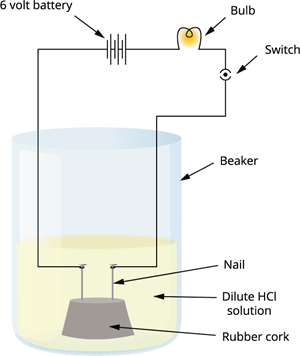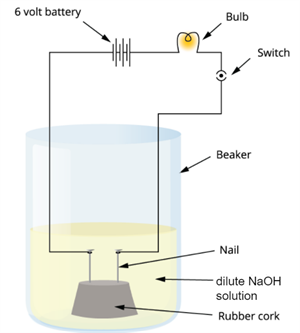PDF chapter test TRY NOW
The common properties of acids:
- Acids possess a sour taste and react with metal forming salt and hydrogen gas. Therefore, common chemical equation can therefore be written as \(Acid + Metal \rightarrow Salt + H_2\)
- Acids will change colour when they come in contact with acid-base indicators.
- Acids react with reactive metals to release hydrogen into the atmosphere.
- Acids form aqueous solutions, which are good conductors of electricity.
From the above equation, we can say that all acids produce hydrogen gas regardless of the with which an acid reacts.
Example:
So, now let us verify this with the help of an activity:
Step 1: Take hydrochloric acid solutions in a beaker.
Step 2: Attach two nails to a cork and place it in a \(100 mL\) beaker.
Step 3: As shown in the figure, connect the nails to the two terminals of a \(6-volt\) battery using a bulb and a switch.

Acid conducts electricity
Step 4: Now, add some diluted \(HCl\) to the beaker and turn on the current, and observe the changes.
Observation: The flow of electric current occurs, which is indicated with the help of a glowing bulb.
Step 5: Repeat the experimental procedure with other solutions such as glucose, alcohol, and sulphuric acid.
Result: The blub glows when we use hydrochloric acid and sulphuric acid solutions, whereas it does not in the case of glucose and alcohol.
Note: Alcohol is a weak acid. Hence, the dissociation of ions is difficult when dissolved in water. Similarly, glucose is a neutral solution, and hence these two solutions do not conduct electricity.
It is confirmed from the above activity that in the presence of acids, blub glows, which indicates the electric current is carried through the solution by ions.
We know that acid contains more \(H^+\) ion concentration which is a cation. This cation is responsible for the acidic property of acid.
Therefore, we can conclude that all compounds containing hydrogen ion concentrations are acidic in nature.
Therefore, we can conclude that all compounds containing hydrogen ion concentrations are acidic in nature.
Let us now see some of the naturally occurring acids.
Natural sources | Acids |
Vinegar | Acetic acid |
Sour milk (Curd) | Lactic acid |
Orange | Citric acid |
Tamarind | Tartaric acid |
Tomato | Oxalic acid |
Lemon | Citric acid |
Ant sting | Methanoic acid |
Nettle sting | Methanoic acid |
The common properties of a base:
- Bases will change the colour during the litmus test. They have a bitter taste.
- When bases react with acids, it forms salt and water thereby losing its basicity.
- Some bases can be great conductors of electricity.
So, now let us verify this with the help of an activity:
Example:
Step 1: Take sodium hydroxide solutions in a beaker.
Step 2: Attach two nails to a cork and place it in a \(100 mL\) beaker.
Step 3: As shown in the figure, connect the nails to the two terminals of a \(6-volt\) battery using a bulb and a switch.

Bases conduct electricity
Step 4: Now, add some diluted \(NaOH\) to the beaker and turn on the current, and observe the changes.
Observation: The flow of electric current occurs, which is indicated with the help of a glowing bulb.
Result: The blub glows when we use sodium hydroxide and calcium hydroxide solutions.
It is confirmed from the above activity that in the presence of basic solution, blub glows, which indicates the electric current is carried through the solution by ions.
We know that a base contains more \(OH^-\) ion concentration which is an anion. This anion is responsible for the basic property of the bases.
Therefore, we can conclude that all compounds containing hydroxide ion concentration are basic in nature.
Therefore, we can conclude that all compounds containing hydroxide ion concentration are basic in nature.
As a result of the preceding experiment, we can conclude that acids and bases share the property of an electrolyte that conducts electricity.
